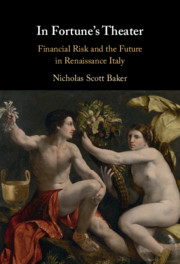Book contents
- In Fortune’s Theater
- In Fortune’s Theater
- Copyright page
- Contents
- Figures
- Preface
- Acknowledgments
- Note on the Text
- Introduction
- 1 Experts in Futurity
- 2 The Future in Play
- 3 Trust in the Future
- 4 The Mercantile Vocabulary of Futurity in Sixteenth-Century Italy
- 5 The Renaissance Afterlife of Boethius’s Moral Allegory of Fortuna
- 6 The Emerging of a New Allegory in Mercantile Culture
- 7 The Shifting Image of Fortuna
- 8 The Separation of Fortuna and Providence
- Conclusion
- Bibliography
- Index
7 - The Shifting Image of Fortuna
Published online by Cambridge University Press: 19 July 2021
- In Fortune’s Theater
- In Fortune’s Theater
- Copyright page
- Contents
- Figures
- Preface
- Acknowledgments
- Note on the Text
- Introduction
- 1 Experts in Futurity
- 2 The Future in Play
- 3 Trust in the Future
- 4 The Mercantile Vocabulary of Futurity in Sixteenth-Century Italy
- 5 The Renaissance Afterlife of Boethius’s Moral Allegory of Fortuna
- 6 The Emerging of a New Allegory in Mercantile Culture
- 7 The Shifting Image of Fortuna
- 8 The Separation of Fortuna and Providence
- Conclusion
- Bibliography
- Index
Summary
Building on the argument of Chapter 5, this chapter argues that the fully developed articulation of a new moral allegory of fortuna developed first in visual culture, connected with mercantile ideas about opportunity. The chapter examines the transformation of the iconography of the figure of fortuna from a distant, regal woman presiding over an ever-turning wheel to a young, alluring, naked woman grasping a sail and offering opportunity to anyone smart, fast, or lucky enough to seize her leading forelock of hair. It traces the development of this new iconography, analyzing the gendered conceptions of temporality that it relied on, and demonstrating the complex variations it which it manifested. The chapter demonstrates that the invention of this new visual image was not a simple linear progression, examining the persistence of elements of the older iconography and the Boethian moral allegory of fortuna in late sixteenth-century artworks. This again reveals the multiplicity and complexity of Renaissance ideas about the future and the absence of a straightforward linear progression from the medieval to the modern.
- Type
- Chapter
- Information
- In Fortune's TheaterFinancial Risk and the Future in Renaissance Italy, pp. 152 - 182Publisher: Cambridge University PressPrint publication year: 2021

